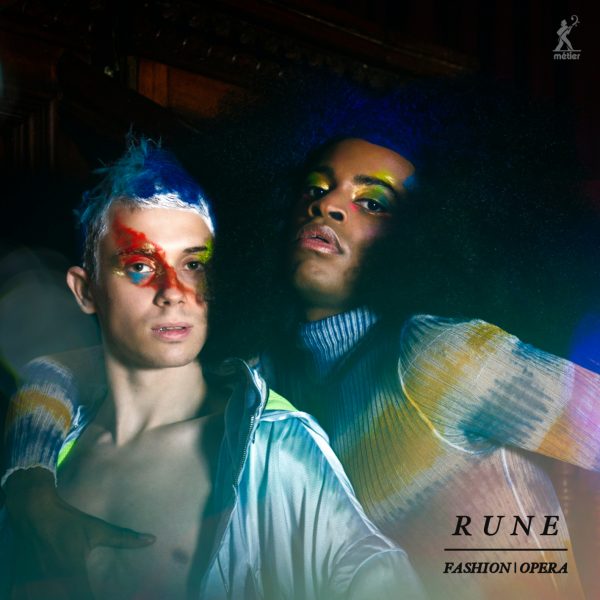Forum Opera
With Rune, his fourth fashion-opera (but the third to be recorded), Alastair White offers a score and a sensitive libretto served by a committed interpretation. The fashion-opera offers a new artistic form, more total, more immersive, full of meaning and connections. The recording of the premiere at Hackney Round Chapel, offered by the Métier label (Divine Art Recordings Group), obviously only gives a partial view of the total experence of fashion-opera: the premiere was also the occasion the launch of a fashion collection from the London house Ka Wa Key and the performance of four contemporary dancers interacting with a sculpture by Sid the Salmon.
In this respect, the album cover lets us glimpse people who are still human but already somewhat fantastic: kinds of exotic, multicolored and seductive birds, free from any gender constraints. Halfway between fantasy and dystopia, on a planet where history is forbidden, a young girl dares to tell the past. Journeying through millennia and galaxies, her story is a takes her from the archipelagos of Khye-Rell to the Runes of the origins of the universe, taking sea routes and transidimensional channels. Articulated in a prologue and three parts, the score offers a relative simplicity where the recurrence of wide intervals in the soprano voice (the voice of the quest and transgression) contrasts with the stable and directed line of the mezzo voice (the voice of the place, of the rule or even of the founding story – in other words, a voice of constancy and unquestioned truths).
Under the direction of Ben Smith, three pianos form the instrumentation. Despite the necessary uniformity of the timbre of the instruments, Ben Smith (who, in addition to conducting, plays one of the keyboards), Siwan Rhys and Joseph Havlat manage to create contrasting sound universes by using all the resources of the instrument (including other elements than the keyboard). Patricia Auchterlonie is a tormented Kes’Cha’Au who deftly tames a vocally demanding score. The difficult jumps of intervals in her part mobilize the two extremes of her range, in particular the high notes which, although sometimes a little forced (which, stylistically, is not without interest), are always perfectly in tune. Simone Ibbet-Brown’s Khye-Rell serves a relatively linear musical line with a warm timbre and a nice roundness. If it is certain that the disc offers only one of the facets of the great show that must be the fashion-opera (we would like to attend a live performance!), it constitutes a beautiful gateway to the musical universe of Alastair White whose work still remains (too) unfamiliar in the French-speaking musical world.
@divineartrecordingsgroup
A First Inversion Company
Registered Office:
176-178 Pontefract Road, Cudworth, Barnsley S72 8BE
+44 1226 596703
Fort Worth, TX 76110
+1.682.233.4978










![Listen to the full suite of Marcel Dupré’s Variations Sur un Noël, Op. 20 from Alexander Ffinch’s #Expectations release today! listn.fm/expectations [in bio]](https://scontent-dfw5-1.cdninstagram.com/v/t51.71878-15/588904367_2327488161082898_8709236950834211856_n.jpg?stp=dst-jpg_e35_tt6&_nc_cat=105&ccb=7-5&_nc_sid=18de74&efg=eyJlZmdfdGFnIjoiQ0xJUFMuYmVzdF9pbWFnZV91cmxnZW4uQzIifQ%3D%3D&_nc_ohc=b5g9hiAMsPAQ7kNvwFAzaYv&_nc_oc=AdkB89uQb4caMJmfq6K5bEmB-ZcmPwU0IMowaL643vXP8r7ivqTlyPgpIp0DqJZYe8XX_RepHMv9w7JFCc0b6m3c&_nc_zt=23&_nc_ht=scontent-dfw5-1.cdninstagram.com&edm=ANo9K5cEAAAA&_nc_gid=cBLDPiUcLdl88q9tUlxhpg&oh=00_AfkRIYhz1RXYkMlxcLiF1YvZGlq5ubFZSd0BdXm9MPZcKQ&oe=695093AA)

![“the ‘Manteca’ Paraphrase – a rare foray into the two-piano medium but here played double-tracked – exudes a panache of which Dizzy Gillespie would surely have approved.… [a] recital well worth investigating.” —Gramophone Magazine with high praise for Ophelia Gordon's debut release, Kapustin: Between the Lines!](https://scontent-dfw5-3.cdninstagram.com/v/t51.82787-15/598796470_18303255136283342_540941604740887837_n.jpg?stp=dst-jpg_e35_tt6&_nc_cat=108&ccb=7-5&_nc_sid=18de74&efg=eyJlZmdfdGFnIjoiRkVFRC5iZXN0X2ltYWdlX3VybGdlbi5DMiJ9&_nc_ohc=qJeKeEK7ScQQ7kNvwGwvEbZ&_nc_oc=AdkYFWtyXUlUelg7YtcKtU7S8sszyleguqNZH5viU-CLTxBvG-tkI88Pz0udszHIEixenuVmJIW5vSilE3IGp8oa&_nc_zt=23&_nc_ht=scontent-dfw5-3.cdninstagram.com&edm=ANo9K5cEAAAA&_nc_gid=cBLDPiUcLdl88q9tUlxhpg&oh=00_AfmPNaAeziqCloyYcT3vNAcdAWv5FkUw8ovqQGVsMjvumQ&oe=69506E04)